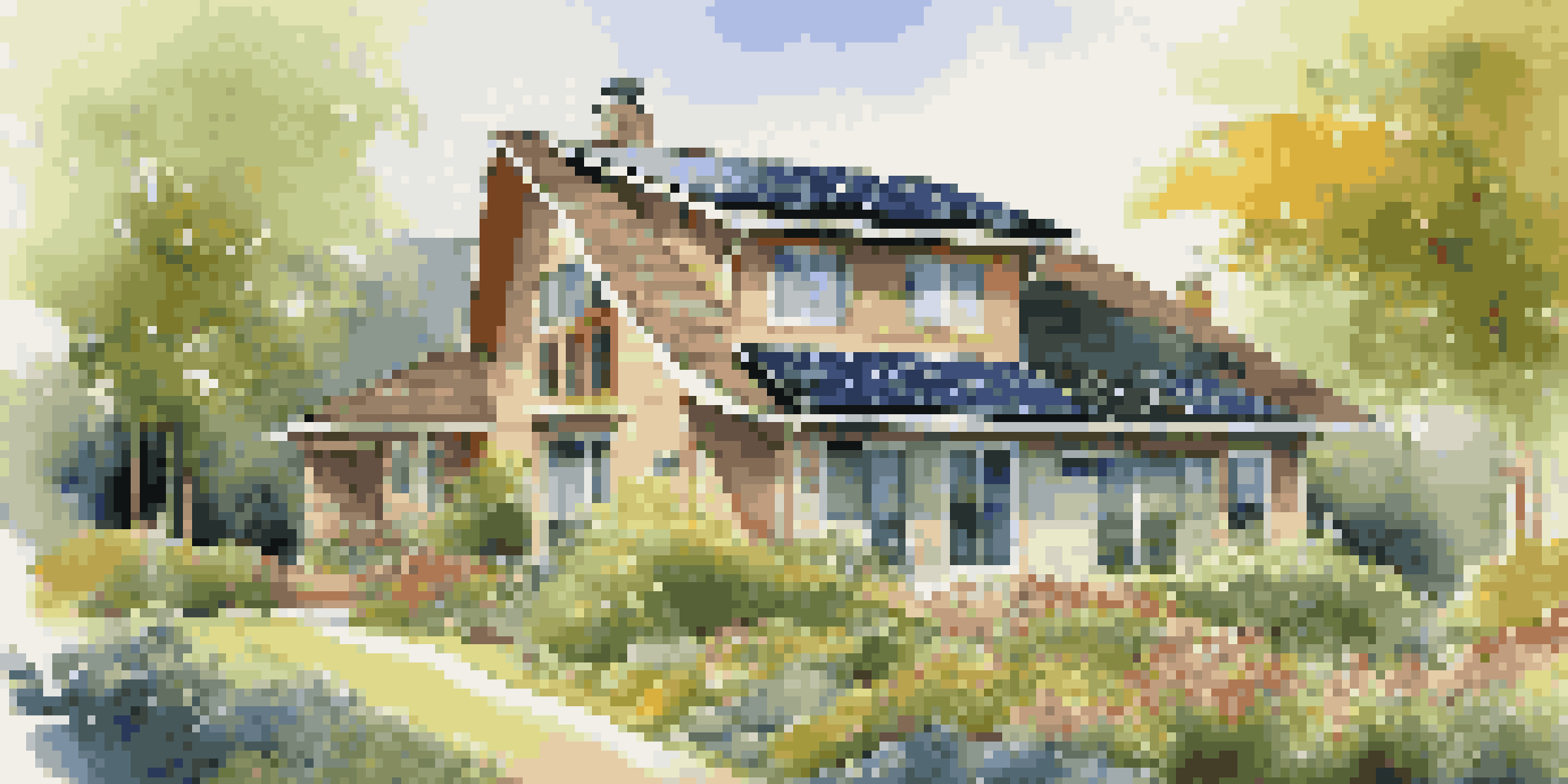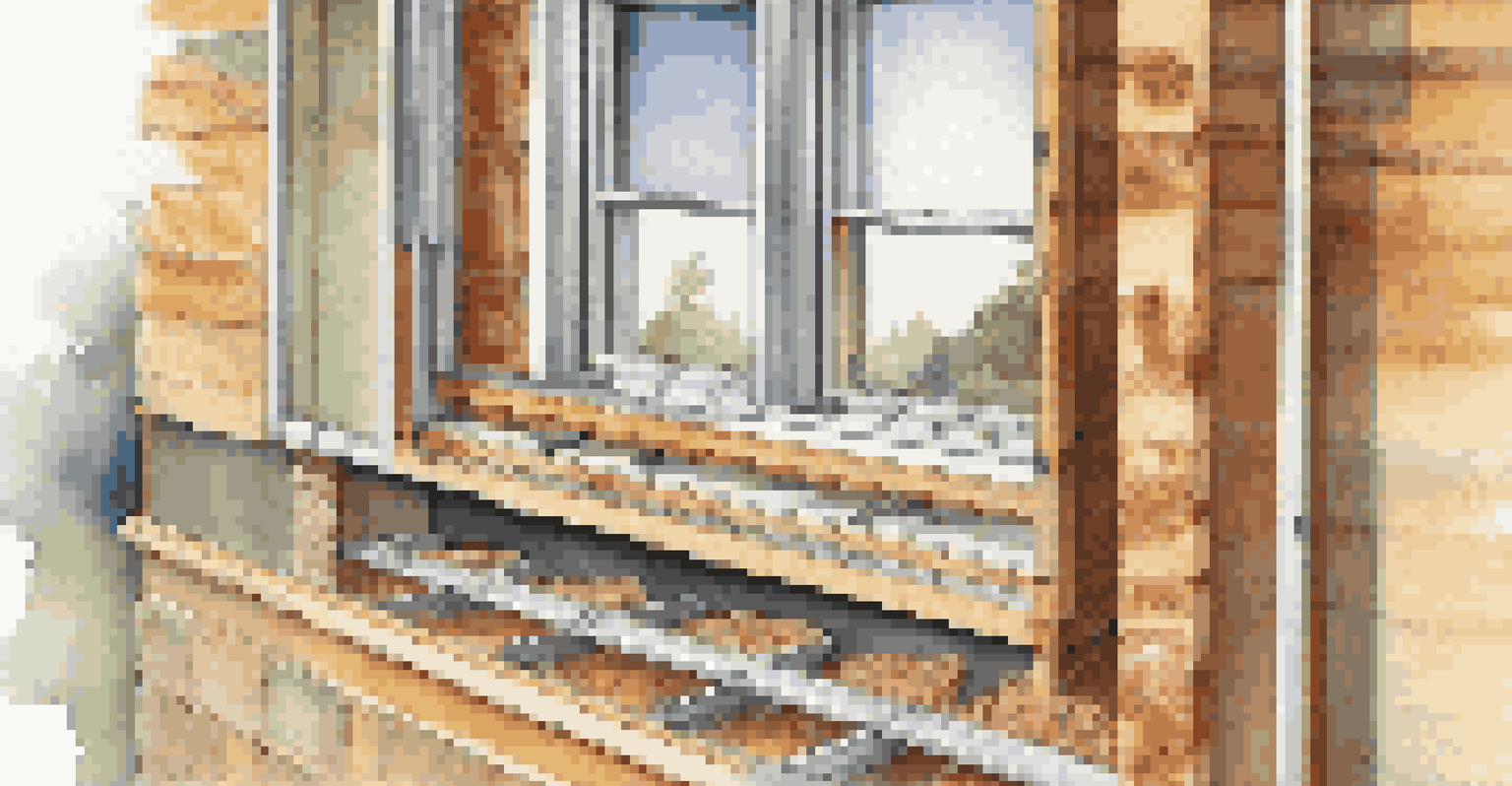Understanding the Basics of Energy-Efficient Home Design

What is Energy-Efficient Home Design?
Energy-efficient home design focuses on reducing energy consumption while maintaining comfort and functionality. It involves using materials and practices that minimize energy waste, such as proper insulation and energy-efficient appliances. Essentially, it's about creating a living space that feels good to be in without draining your wallet or the environment.
The greatest threat to our planet is the belief that someone else will save it.
Incorporating energy-efficient designs can significantly lower utility bills and reduce the carbon footprint of your home. For instance, using passive solar design, which takes advantage of sunlight for heating, can drastically cut down on heating costs. This approach not only benefits the homeowner financially but also contributes positively to the planet.
As more homeowners seek sustainable living options, understanding energy-efficient design becomes crucial. It's not just about building new homes; existing structures can also be retrofitted to improve energy efficiency. This shift in mindset promotes a healthier lifestyle and a more sustainable future.
The Importance of Insulation in Home Design
Insulation is a vital component in energy-efficient home design because it helps maintain a consistent indoor temperature. Proper insulation minimizes heat transfer, keeping your home warm in winter and cool in summer. Think of insulation as a cozy blanket that wraps around your house, ensuring you stay comfortable regardless of the weather outside.

Using high-quality insulation materials can significantly impact your energy bills. For instance, spray foam insulation offers superior sealing capabilities compared to traditional fiberglass. This means less energy is wasted, leading to lower heating and cooling costs over time.
Reduce Costs with Energy Efficiency
Energy-efficient home design lowers utility bills while enhancing comfort and sustainability.
Additionally, effective insulation contributes to a healthier indoor environment by reducing drafts and moisture buildup. This not only enhances comfort but also helps prevent issues like mold growth. Investing in good insulation is a fundamental step toward creating an energy-efficient home.
Choosing Energy-Efficient Windows and Doors
Windows and doors play a crucial role in energy efficiency, as they are common sources of heat loss. Opting for energy-efficient windows, such as double-glazed or Low-E glass, can drastically reduce energy consumption. These types of windows are designed to keep the desired temperature inside your home, much like a thermos keeps your coffee hot.
Energy efficiency is not just a policy opportunity; it is a way of life.
Additionally, well-sealed doors prevent drafts and maintain indoor climate control. Look for doors with energy ratings and materials that provide better insulation. This investment not only enhances energy savings but also increases the overall aesthetic appeal of your home.
Incorporating energy-efficient windows and doors can also boost your home’s value. Potential buyers are increasingly interested in homes that offer lower energy costs and improved comfort. By upgrading these elements, you enhance both your living experience and your property’s marketability.
Incorporating Renewable Energy Sources
Integrating renewable energy sources, like solar panels, is a key aspect of energy-efficient home design. These systems harness natural energy from the sun, providing a sustainable power supply while reducing dependence on fossil fuels. Imagine being able to power your home using sunlight—it's like having your cake and eating it too!
Solar panels can significantly lower electricity bills and may even allow homeowners to sell excess power back to the grid. This not only promotes energy independence but also fosters a sense of community contribution toward environmental sustainability. The initial investment may seem daunting, but the long-term savings and environmental benefits often outweigh the costs.
Insulation is Key for Comfort
Proper insulation maintains consistent indoor temperatures, significantly impacting energy savings.
Moreover, renewable energy systems can increase your home’s resale value. More buyers are looking for eco-friendly features, making homes with solar panels or wind energy systems more appealing. As we transition to greener living, embracing renewable energy in your home design creates a win-win situation.
Smart Home Technology for Energy Efficiency
Smart home technology is revolutionizing energy-efficient home design by automating and optimizing energy use. Devices like smart thermostats can learn your schedule and adjust heating and cooling accordingly, ensuring energy is used only when needed. It’s like having a personal assistant for your home’s energy management!
These technologies not only enhance convenience but also provide real-time data on energy consumption. By monitoring usage patterns, homeowners can identify areas to improve efficiency. For example, you might discover that your living room is consistently cooler than the rest of the house, prompting adjustments to improve comfort and efficiency.
As smart home technology continues to evolve, it becomes easier to integrate energy-saving practices into daily life. From smart lighting systems that adjust based on occupancy to automated shades that control sunlight, these innovations make it simpler to maintain an energy-efficient lifestyle. Investing in smart technology is a forward-thinking step toward a more sustainable home.
Sustainable Landscaping Practices
Sustainable landscaping is an often-overlooked aspect of energy-efficient home design that can significantly impact energy use. By choosing native plants and planning for natural shade, homeowners can create outdoor spaces that reduce cooling costs. For instance, strategically placed trees can provide shade in the summer, keeping your home cooler and reducing reliance on air conditioning.
Incorporating features like rain gardens or permeable paving can help manage stormwater effectively, minimizing runoff and promoting groundwater recharge. This not only supports local ecosystems but also reduces the need for extensive irrigation, preserving water resources. Think of it as creating a mini-ecosystem that thrives alongside your home.
Embrace Renewable Energy Sources
Integrating solar panels and other renewable systems promotes energy independence and increases home value.
Moreover, sustainable landscaping enhances the overall beauty and functionality of your property. A well-designed landscape not only provides aesthetic appeal but also increases property value. By investing in sustainable practices, you contribute to a healthier environment while enjoying a vibrant outdoor space.
The Benefits of Energy-Efficient Home Design
Adopting energy-efficient home design practices offers a multitude of benefits, both immediate and long-term. One of the most apparent advantages is the reduction in utility bills, which allows homeowners to allocate funds to other important areas of life. Picture being able to enjoy a family vacation or save for a dream project because your energy costs are significantly lower.
Additionally, energy-efficient homes often provide a more comfortable living environment. Improved insulation, efficient windows, and smart technology work together to create a consistent indoor climate. This means fewer temperature fluctuations and a more pleasant experience, regardless of the season.

Finally, energy-efficient design contributes positively to the environment by decreasing greenhouse gas emissions. By reducing energy consumption, you play a part in combating climate change, promoting a healthier planet for future generations. Embracing these practices is not just a personal benefit; it’s a collective step toward sustainability.